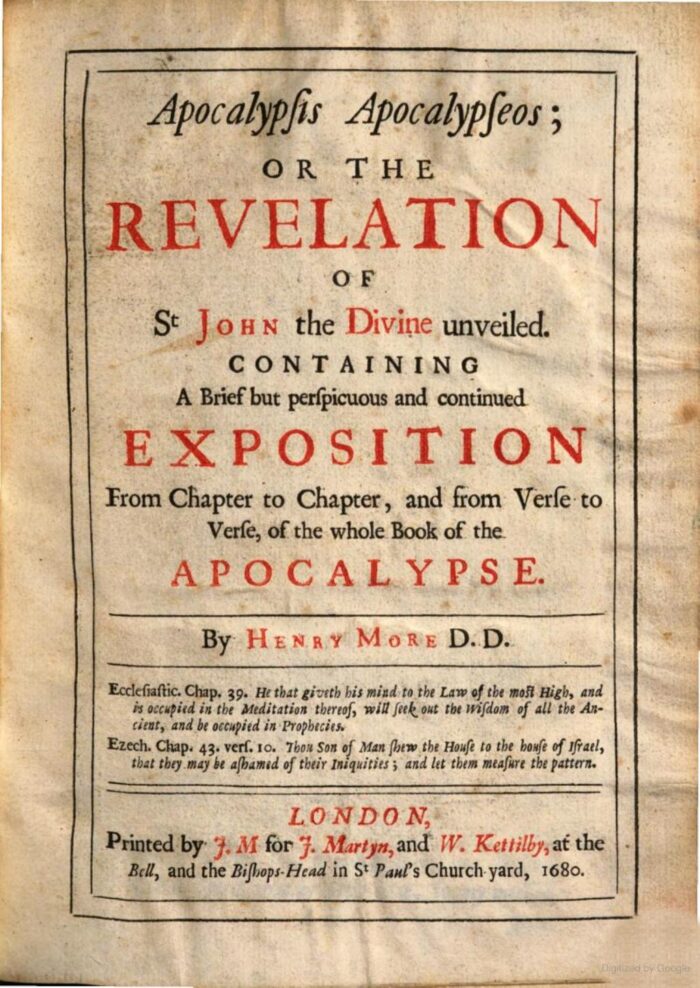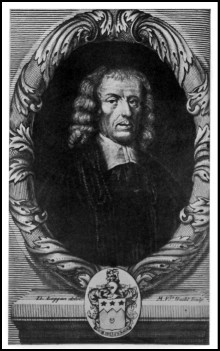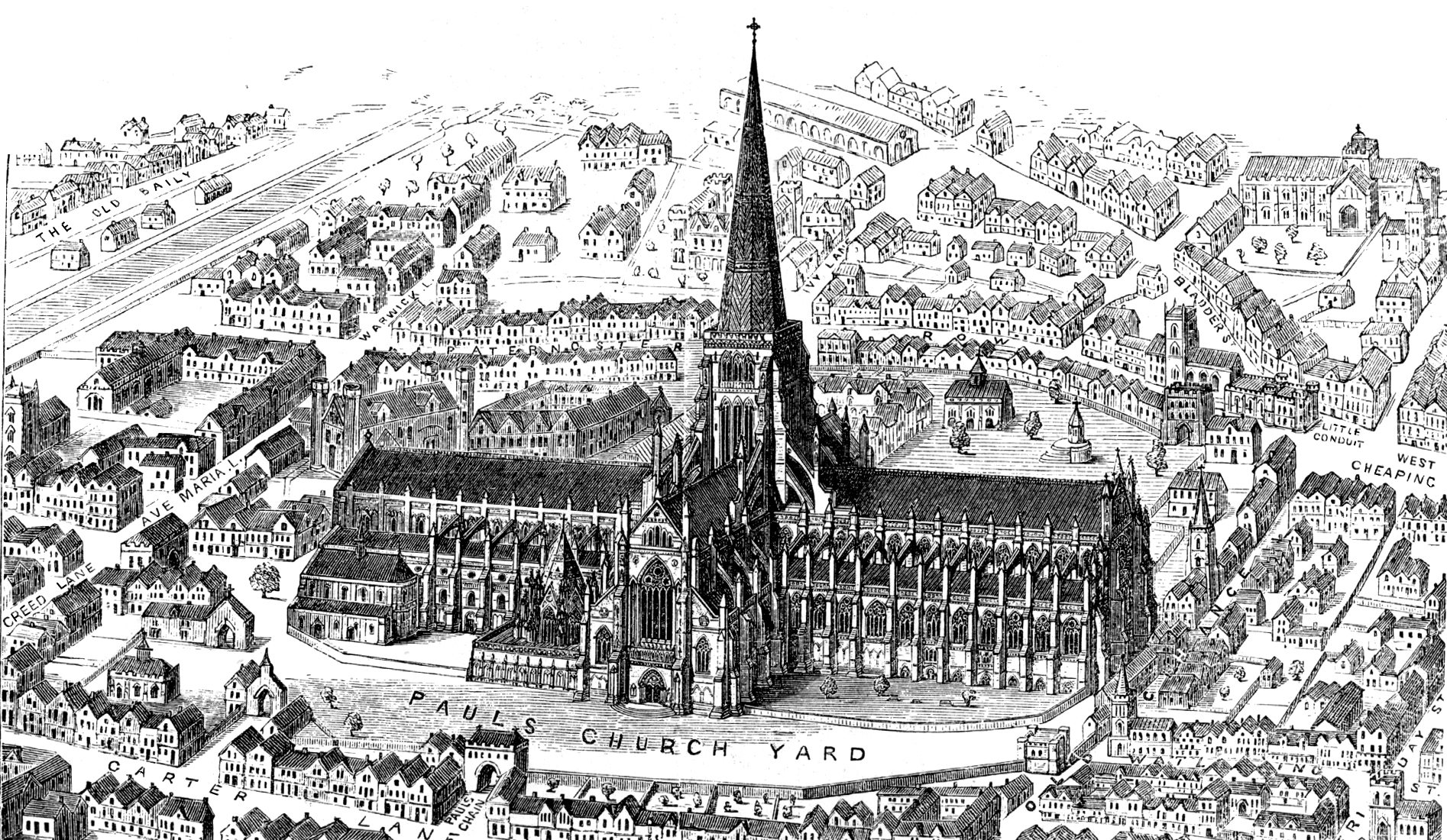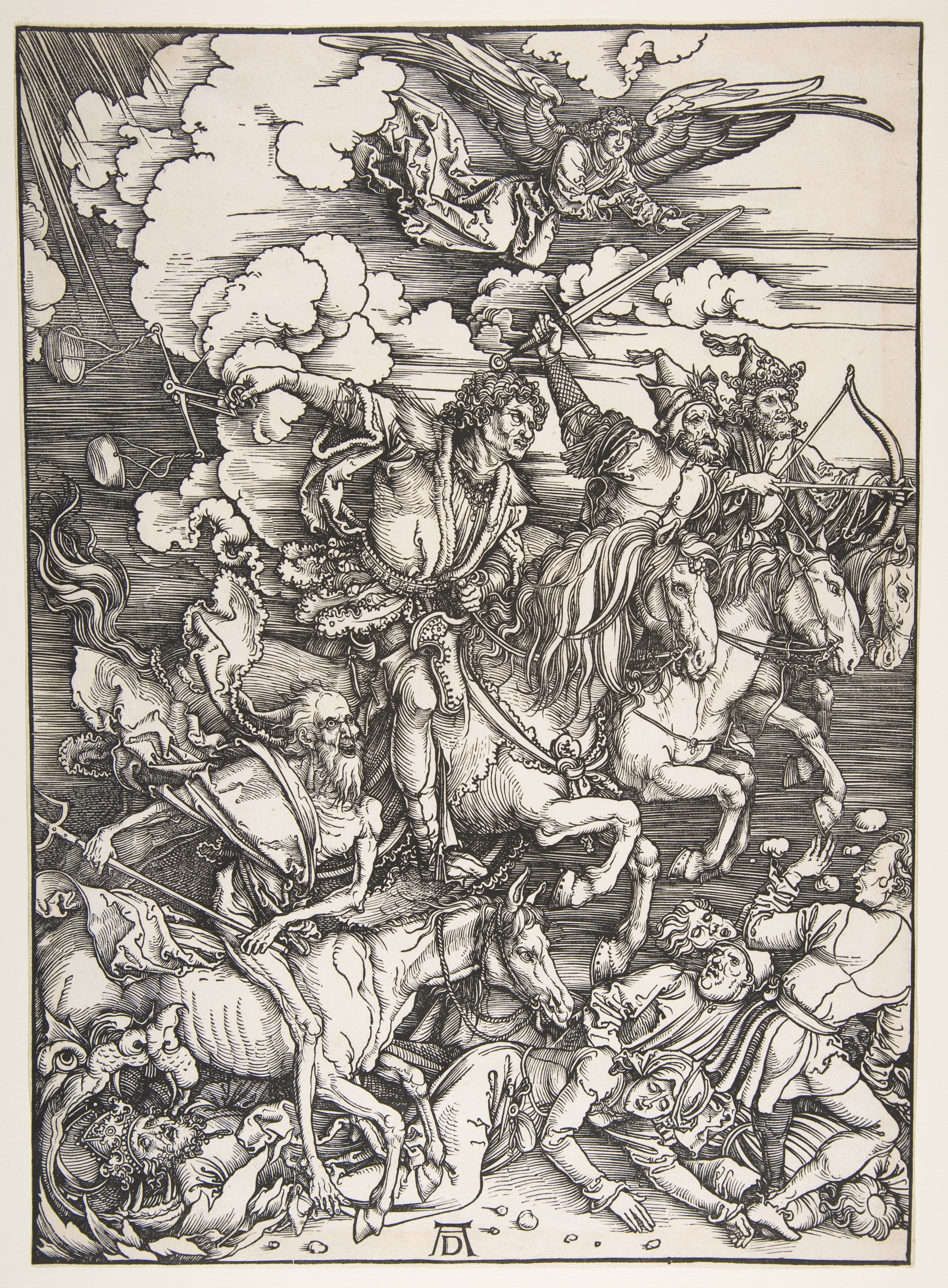Apocalypsis Apocalypseos; OR THE REVELATION OF St. JOHN the Divine unveiled.
Apocalypsis Apocalypseos; OR THE REVELATION OF St. JOHN the Divine unveiled.
by Sharlène and Renée

|
Title
|
Apocalypsis Apocalypseos; OR THE REVELATION Of St. JOHN the Divine unveiled. CONTAINING A Brief but perspicuous and continued EXPOSITION From Chapter to Chapter, and from Verse to Verse, of the whole Book of the APOCALYPSE. By HENRY MORE D.D.
|
|
Contributor
|
More, Henry (editor/author); J.M (printer)
|
|
Date
|
1680
|
|
Place
|
LONDON, at the Bell and the Bishop’s Head in St. Paul’s Church yard
|
|
Language
|
English
|
|
Source
|
Available on Google Books:
Click here |
The Author
Henry More (1613-1687) was an English theologian and philosopher who was part of a group of religious scholars called the Cambridge Platonists1. The group’s aim was to use reason as the basis of knowledge and to not simply accept tradition blindly2. More, who was raised by Calvinist parents, rejected the Calvinist doctrine of predestination, and instead believed in a God with morally perfect principles who would not subject souls to a strict predestination3. Building from that belief, More argued for a strict dualistic separation of the body from the immortal soul which exists before and after inhabiting the body4.

The Work
More published his text Apocalypsis Apocalypseos; or, the Revelation of St John the Divine unveiled… in 1860 to help explain the Book of Revelation to the average reader. In the preface he explains that in the Book of Revelation, “Though there is a marvelous artifice of Concealment in it, yet there is as sure an artifice of Revealment, as I hope will appear by this our Exposition5.” Passage by passage, More interposes his explanations and interpretations between the quotes from the bible. He differentiates the bible verses from his own words by printing them “… in a black English Letter, the more easily to be distinguished from the Comment…6” In this way the reader can continually see both verse and comment at the same time, so they can “…with more ease and assuredness judge of the Faithfulness and Agreeableness of our Exposition7.” At the end he concludes with additional explanations found in the “Notes” section. More’s interpretations of the apocalyptic prophecies sparked discussions and debates among his readers.8
Biblical Commentaries
More’s commentary fits into a long tradition of biblical commentaries on the Apocalypse in 16th and 17th century Europe, where scholars and theologians sought to interpret the prophetic visions of Revelation in light of the political and social upheavals of their time. A prominent example is Joseph Mede (1586–1638), an English biblical scholar whose Clavis Apocalyptica (1627) presented a systematic and innovative approach to The Book of Revelation.9 Mede proposed that the visions in the text form a cohesive chronological order, providing a structured framework to understand both historical and future events.10 This approach influenced later scholars, including More, who built upon Mede’s rational and methodical framework while adapting it to the concerns of his own era. More, for example, was writing for a British audience recovering from the turmoil of the English Civil War, the Interregnum, and the Restoration—events that had deeply unsettled social and political order.
Another example is John Napier (1550–1617), a Scottish mathematician and theologian, whose A Plaine Discovery of the Whole Revelation of St. John (1593) used mathematical calculations and historical events to explain Revelation.11 Like More, Napier and other commentators employed the vivid imagery and symbols of Revelation to make sense of the challenges and uncertainties of their times, connecting the biblical prophecies to the political, social, and historical issues that their audiences were facing.
Printing at St. Paul’s Churchyard

At the close of the 16th century, many books such as Apocalypsis Apocalypseos were being printed in the churchyard of St. Paul’s Cathedral in London that it had become the main center of the book trade for the entire country.12
The initals J. M. is the only indication of the printer of Apocalypsis Apocalypseos; however, the title page reveals it was printed for J. Martyn and W. Kettilby, both of whom were active publishers and booksellers at St. Paul’s Churchyard.13
Ex Libris
The copy of Apocalypsis Apocalypseos is available online and has an ex libris on the verso of the title page. The bookplate belongs to the Welsh Tory politician Francis Gwyn (1673-1727). It is a restoration style ex libris characterized by heavily ornate mantlings that enclose the helm on the top and sides14.
Visionvm Apocalypticarvm Tabvla Generalis
More’s diagram is an updated and more comprehensive version of that presented by Mede in the second edition of his Clavis Apocalyptica (The Key to the Apocalypse, 1632). The diagram seeks to explain the synchronisms and relationships of different aspects of the apocalyptic visions.15
Dürer’s Woodcut of The Book of Revelation: Chapter 6

Chapter 6: The Book of Revelation
Albrecht Dürer’s (1471-1528) woodcut, The Four Horsemen of the Apocalypse, illustrates the catastrophic figures representing Conquest, War, Pestilence (or famine), and Death16. This image was part of a series of fifteen illustrations created for a 1498 edition of Dürer’s Apocalypse, a topic that was especially popular during periods of uncertainty. In 1511, after the predicted end of the world did not occur, the plates were reissued, further establishing Dürer’s lasting reputation as a master printmaker17.
The horsemen are described in More’s Apocalypsis Apocalypseos, specifically in Revelation 6:1-8 with traditional colours—white, red, black, and pale. To help readers distinguish between the biblical text and his commentary, More presents the scripture in bold, while his interpretative insights appear in regular font:
“And I saw and behold a white horse, and be that fate on him saw a Bow […] a white Horse signifies a great Commander or Emperour, Righteous, Prosperous and Glorious in his undertaking18”
“And when he had opened the second Seal, I heard the second Beast […] And there went out another horse that was red, a colour significant enough of the effusion of blood […] And power was given to him that late thereon to take peace from the Earth, and that they would kill one another, and there was given to him a great Sword19“
“And when he had opened the third Seal, I heard the third Beast; that had a face like a man […] And I beheld, and lo a black horse, and be that fate on him had a pair of balances in his hand. The black colour betokens Gravity, Severity, Justice, which Justice also is intimidated by the face of a Man this third Beast is said to have, Prudence and Justice being the proper characters of a Man : Which sutes well with the last part of the description, the pair of Balances in the Riders hand; which argues him Severe, Just, Frugal and Provident20“.
“And when he had opened the fourth Seal, I heard the fourth Beast, that was like a flying Eagle […] And I looked and behold a pale Horse: which colour of the Horse is very sutable to the Name of the Rider. […] And his name that fate on him was Death: And Hell followed him, that is the Grave, which is made a person here as Death is, and as it were his Lackey to follow him21“.
“And Power was given unto them over the fourth part of the Earth […] To kill with the Sword, and with Hunger and with Death, that is, with Famine and Pestilence, and with the Beasts of the Earth22“.
Dürer’s woodcut translates the colours of the horses into a black and white representation, revealing his artistic interpretation of the text. He skillfully arranges the horsemen in the sequence described in the Book of Revelation, emphasizing their impending chaos and capturing the ferocity of their approach, creating a powerful commentary on doom and transformation.
Test your knowledge of the four horsemen of the Apocalypse with an interactive Twine story!
Bibliography
Beiser, Frederick. “Cambridge Platonism.” In Routledge Encyclopedia of Philosophy. Taylor and Francis. Accessed October 17, 2024. https://www.rep.routledge.com/articles/thematic/cambridge-platonism/v-1. https://doi.org/10.4324/9780415249126-DA011-1.
Britannica. “John Napier.” Last modified November 15, 2024. Accessed November 15, 2024. https://www.britannica.com/biography/John-Napier.
Carlone, Dominic. Bookselling at Paul’s Churchyard.
The Map of Early Modern London, Edition 7.0. Ed. Janelle Jenstad. Victoria: University of Victoria. Accessed May 05, 2022. mapoflondon.uvic.ca/edition/7.0/BOOK2.htm.
Castle, Egerton. English Book-Plates: Ancient and Modern. London: G. Bell & Sons, 1574.
Fitzpatrick, Clare. “Miraculous and Supernaturall Effects” in the Works of Henry More. PhD thesis, Birkbeck, University of London, 2019. Online Repository of Birkbeck Institutional Theses (ORBIT). Unpublished. Available at: https://eprints.bbk.ac.uk/id/eprint/40434/.
Henry, John. “Henry More.” The Stanford Encyclopedia of Philosophy (Summer 2023 Edition), edited by Edward N. Zalta and Uri Nodelman. Stanford University, 2023. https://plato.stanford.edu/archives/sum2023/entries/henry-more/.
Hickson, Sally. “Albrecht Dürer, The Four Horsemen of the Apocalypse.” Smarthistory, accessed October 17, 2024. https://smarthistory.org/albrecht-durer-four-horsemen/.
Oxford Reference. “Walter Kettilby.” 2011. Accessed November 15, 2024. https://www.oxfordreference.com/display/10.1093/oi/authority.20110803100145623.
Rostenberg, Leona. “John Martyn, ‘Printer to the Royal Society.’” The Papers of the Bibliographical Society of America 46, no. 1 (1952): 1–32. http://www.jstor.org/stable/24298625.
Royal Academy of Arts. “Walter Kettilby (before 1656–1711).” Accessed November 15, 2024. https://www.royalacademy.org.uk/art-artists/name/walter-kettilby.
Wikimedia Commons contributors. “Portrait of Henry More.” Wikimedia Commons. Accessed October 22, 2024. https://commons.wikimedia.org/w/index.php?curid=169068.
Wikimedia Commons contributors. “St Paul’s old. From Francis Bond, Early Christian Architecture. Last book 1913.” Wikimedia Commons. Accessed November 15, 2024. https://fr.m.wikipedia.org/wiki/Fichier:St_Paul%27s_old._From_Francis_Bond,_Early_Christian_Architecture._Last_book_1913..jpg
- Henry, “Henry More,” para 1. ↩︎
- Beiser, “Cambridge Platonism,” para 1. ↩︎
- Henry, “Henry More,” para 3. ↩︎
- Henry, “Henry More,” para 4. ↩︎
- More, Apocalypsis apocalypseos… V. ↩︎
- More, Apocalypsis apocalypseos… XXXI. ↩︎
- More, Apocalypsis apocalypseos… XXXI. ↩︎
- Fitzpatrick, “Miraculous and supernaturall effects in the works of Henry More,” p. 89 ↩︎
- Oxford Reference, “Joseph Mede,” ↩︎
- Oxford Reference, “Joseph Mede,” ↩︎
- Britannica,”John Napier,” ↩︎
- Carlone, “
Bookselling at Paul’s Churchyard
” para 1. ↩︎ - Royal Academy of Arts, “Walter Kettilby (before 1656–1711),” para 1.; Rostenberg “John Martyn, ‘Printer to the Royal Society,’” p. 2 ↩︎
- Castle,” English Book-Plates: Ancient and Modern, pg 60. ↩︎
- Fitzpatrick, “Miraculous and supernaturall effects” in the works of Henry More,” p. 88 ↩︎
- Hickson, Albrecht Dürer, “The Four Horsemen of the Apocalypse,” para 1 ↩︎
- Hickson, Albrecht Dürer, “The Four Horsemen of the Apocalypse,” para 2. ↩︎
- More, Apocalypsis apocalypseos… 53. ↩︎
- More, Apocalypsis apocalypseos… p.54 ↩︎
- More, Apocalypsis apocalypseos… p.55 ↩︎
- More, Apocalypsis apocalypseos… p.56
↩︎ - More, Apocalypsis apocalypseos… p.56 ↩︎



